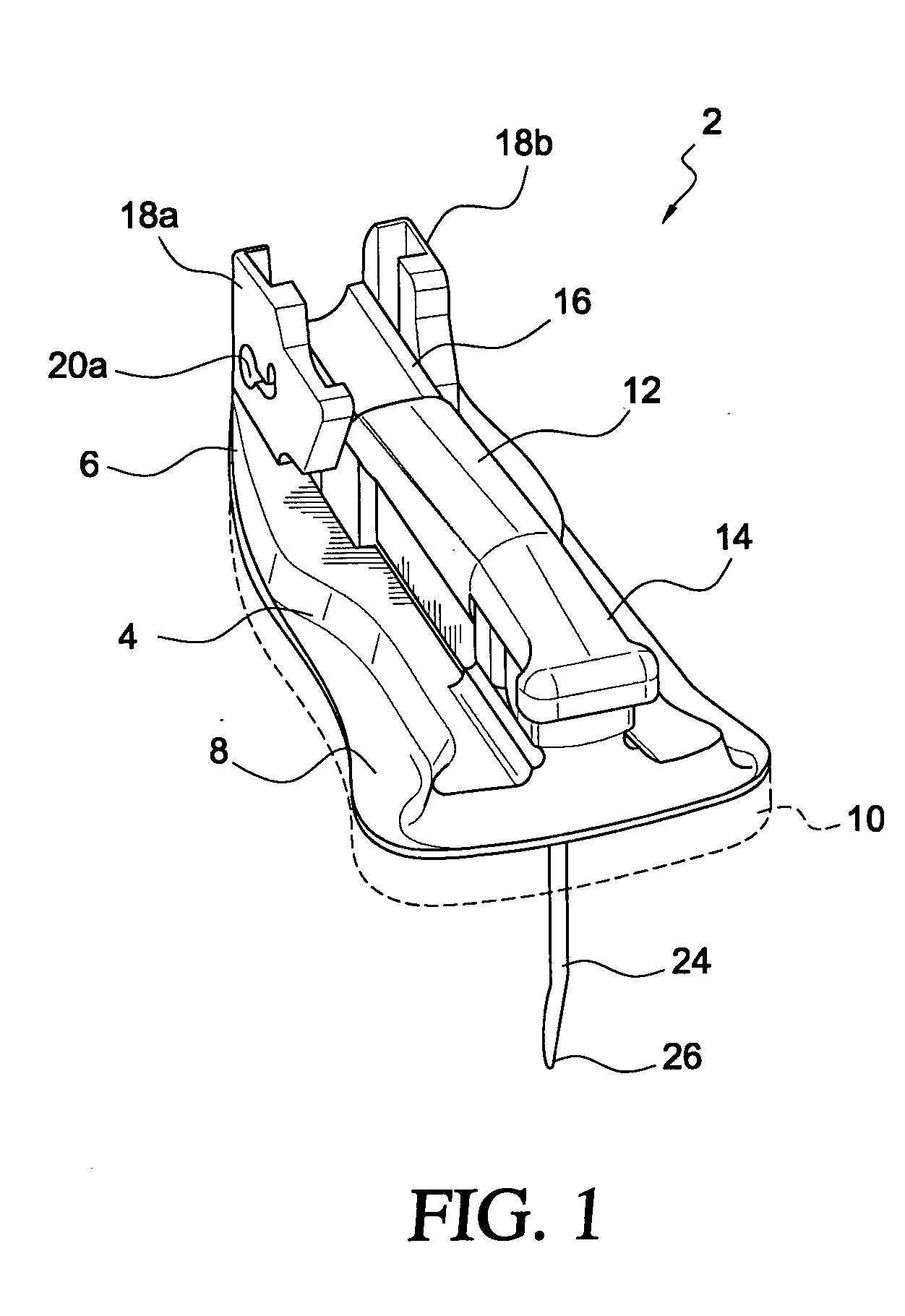Removable sharps device for accessing a portal reservoir
a technology of a portal reservoir and a sharps device, which is applied in the direction of intravenous devices, infusion needles, other medical devices, etc., can solve the problems of accidental injury, unnecessarily splattering around, and contaminated fluid at the tips of the needle may adhere to the well,
- Summary
- Abstract
- Description
- Claims
- Application Information
AI Technical Summary
Benefits of technology
Problems solved by technology
Method used
Image
Examples
first embodiment
[0038] the safety needle inserter device component of the instant invention is shown in FIGS. 1-4. As shown, the safety needle inserter 2 has a base 4 that has a distal portion 6 and a proximal portion 8. A foam pad or layer 10 coated with an adhesive for adhering base 4 to the patient may be mounted to the underside, or the lower surface, of base 4. An arm having a first end 14 and a second end 16 is hingedly connected to two uprights 18a and 18b, respectively, at distal portion 6 of base 4. Two lugs 19, one at each side of second end 16 of arm 12, are movably journaled to the respective guide holes 20a and 20b of the respective uprights 18a and 18b, to thereby hingedly and movably connect arm 12 to base 4. Only lug 19a is shown in FIG. 2. When uplifted in the direction as indicated by directional arrow 22, arm 12 is pivotally moved, via its second end 16, in an upward direction relative to base 4.
[0039] A needle, or sharp cannula 24, is mounted to the underside of arm 12, at its f...
second embodiment
[0044]FIG. 5 is an illustration of the safety needle inserter of the instant invention. Other than the overall look of the safety-needle inserter and the various parts of the locking mechanisms which coact to lock arm 12 in place relative to base 4, the safety needle inserter of the FIG. 5 embodiment functions in the same way as the embodiment shown in FIGS. 1-4. The components that are the same as those of the earlier disclosed embodiment are labeled the same.
[0045] As shown more clearly by the partial cut-away view, the tip 26 of sharp cannula 24, when withdrawn from the portal reservoir and the patient, is maintained within a bore 42 that is formed at the proximal portion 8 of base 4. As shown, bore 42 is defined between opening 44 at the underside or lower surface of base 4 and an opening 44a at the upper side or upper surface 46 of base 4. A dam 48 extends from proximal portion 8 of base 4 and serves as an additional safety feature to ensure that-the tip 26 of cannula 24 could ...
third embodiment
[0047] the safety needle inserter of the instant invention is shown in FIGS. 6-8. This embodiment is a modification of the simplified embodiment shown in FIG. 5 in that uprights 54 have been reconfigured to allow additional flexibility by the adding of a notch 56 thereto. As a consequence, when arm 12 is pulled upwards along the direction as indicated by directional arrow 22, each of uprights 54 would tend to flex away, until the underside 16a of arm 12 clears the top edge 54b of the respective uprights 54. At which time, uprights 54 will return to their respective memorized original positions so as to move upper surfaces 54b of uprights 54 under the bottom surface 16a of arm 12 and more specifically those surfaces of the bosses 52, or areas proximate thereto, to thereby prevent downward movement of arm 12 along the direction as indicated by directional arrow 36.
[0048] Further, similar to the embodiment shown in FIGS. 1-4, respective grooves or recesses 34 are provided at the uprigh...
PUM
 Login to View More
Login to View More Abstract
Description
Claims
Application Information
 Login to View More
Login to View More - R&D
- Intellectual Property
- Life Sciences
- Materials
- Tech Scout
- Unparalleled Data Quality
- Higher Quality Content
- 60% Fewer Hallucinations
Browse by: Latest US Patents, China's latest patents, Technical Efficacy Thesaurus, Application Domain, Technology Topic, Popular Technical Reports.
© 2025 PatSnap. All rights reserved.Legal|Privacy policy|Modern Slavery Act Transparency Statement|Sitemap|About US| Contact US: help@patsnap.com



